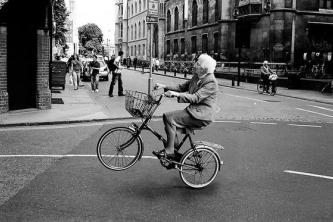
While cycling appears to be an ecological alternative to cars for certain situations, the purpose of this research is to detail the reasons why cycling is less common among the over 60s and to consider ways of remedying this. The research will focus in particular on how the representation of bodies and their relationship to exercise, which are especially significant when people’s physical and cognitive capacities are declining, influence their attitudes towards cycling.
Cycling among the elderly is a practice that meets both environmental goals - promoting active modes within the general population - and health objectives - promoting physical activity among the elderly. Studying how this group relates to cycling therefore responds to important public policy issues.
In the metropolitan area of Lyon, in 2015, people aged 65 and over cycled the least when compared to other age groups. Based on Pattaroni’s proposed definition of lifestyles 1, Alexandre Rigal suggests two hypotheses to explain this weak practice. On the one hand, he posits that the values and conceptions of a good life for the elderly discourage them from cycling: their generation lived through the rise of the car and its mass expansion within the population, which is why they have a greater tendency to get behind the wheel than other age groups. On the other hand, he postulates that for the over 60s, their capacities and relationship to the environment make cycling difficult, as their waning cognitive and physical abilities as well as the manner in which their bodies are represented discourage them from getting on a bicycle.
To describe these cycling bodies, Alexandre Rigal will rely on Goffman’s notion of a vehicular unit, to analyze how the stigmatized bodies of elderly cyclists are exposed to other people’s gaze and to highlight the importance of avoiding embarrassing situations in order to maintain their dignity and be respected by others.
This approach will be complemented by emphasizing the socially constructed experience of the physical and cognitive exercise required to get around on a non-motorized bicycle. The relationship to exercise will be understood here via three dimensions: minimization, entertainment and training. First, vehicle and infrastructure design can seek to reduce as much as possible the amount of exercise required, so as to encourage the practice of cycling. Second, some of the exercise involved in cycling can be promoted not for its physical benefits, but as a source of entertainment, for example, by taking place in a pleasant or enjoyable environment. Third, exercise training can help improve how physical effort is perceived.
The research will allow us to gain a precise vision of the bodily capacities of the over 60s in relation to the practice of cycling, considering the constraints linked to body norms and lifestyles in general. The goal is to describe cycling practices in connection with situated lifestyles, i.e., activity programs. This will help explain the low incidence of cycling among older people and how it could be promoted.
The research will be conducted in three stages. First, we will produce an overview of the current relationship between bodies, exercise and mobility among elderly people. Then, a quantitative survey carried out in the city of Lyon will allow us to identify how strongly the representation of bodies and cognitive and physical capacities impact the use and non-use of bicycles among the elderly, looking at differences according to the age of the respondents. We will interview cyclists and non-cyclists and then analyze their profiles, their mobility practices, their aspirations, their learning process and their cycling practices. Finally, the study will involve a qualitative survey to examine the experiences of exercise and cognitive limits, the importance of the gaze of others, and the experience of new cyclists as well as experienced cyclists.
Results are expected in 2024.
For the Mobile Lives Forum, mobility is understood as the process of how individuals travel across distances in order to deploy through time and space the activities that make up their lifestyles. These travel practices are embedded in socio-technical systems, produced by transport and communication industries and techniques, and by normative discourses on these practices, with considerable social, environmental and spatial impacts.
En savoir plus xLifestyles
Policies
To cite this publication :
Alexandre Rigal et BVA Xsight (08 February 2022), « Between public exposure and the relationship to exercise: the moving bodies of elderly cyclists », Préparer la transition mobilitaire. Consulté le 11 May 2025, URL: https://forumviesmobiles.org/en/project/15425/between-public-exposure-and-relationship-exercise-moving-bodies-elderly-cyclists

Projects by Forum Vies Mobiles are licensed under a Creative Commons Attribution-NonCommercial-ShareAlike 3.0 France License.
Permissions beyond the scope of this license may be available at contact.
Other publications